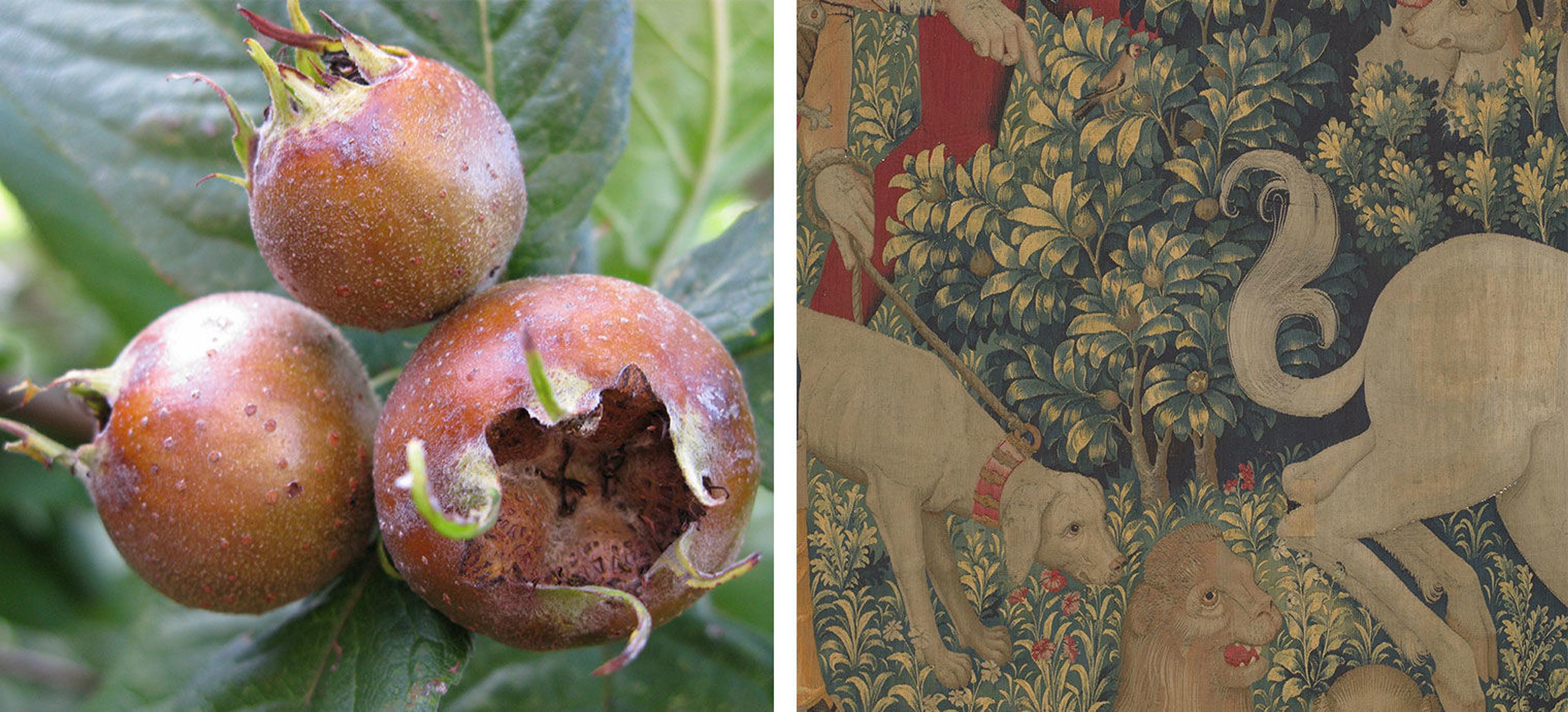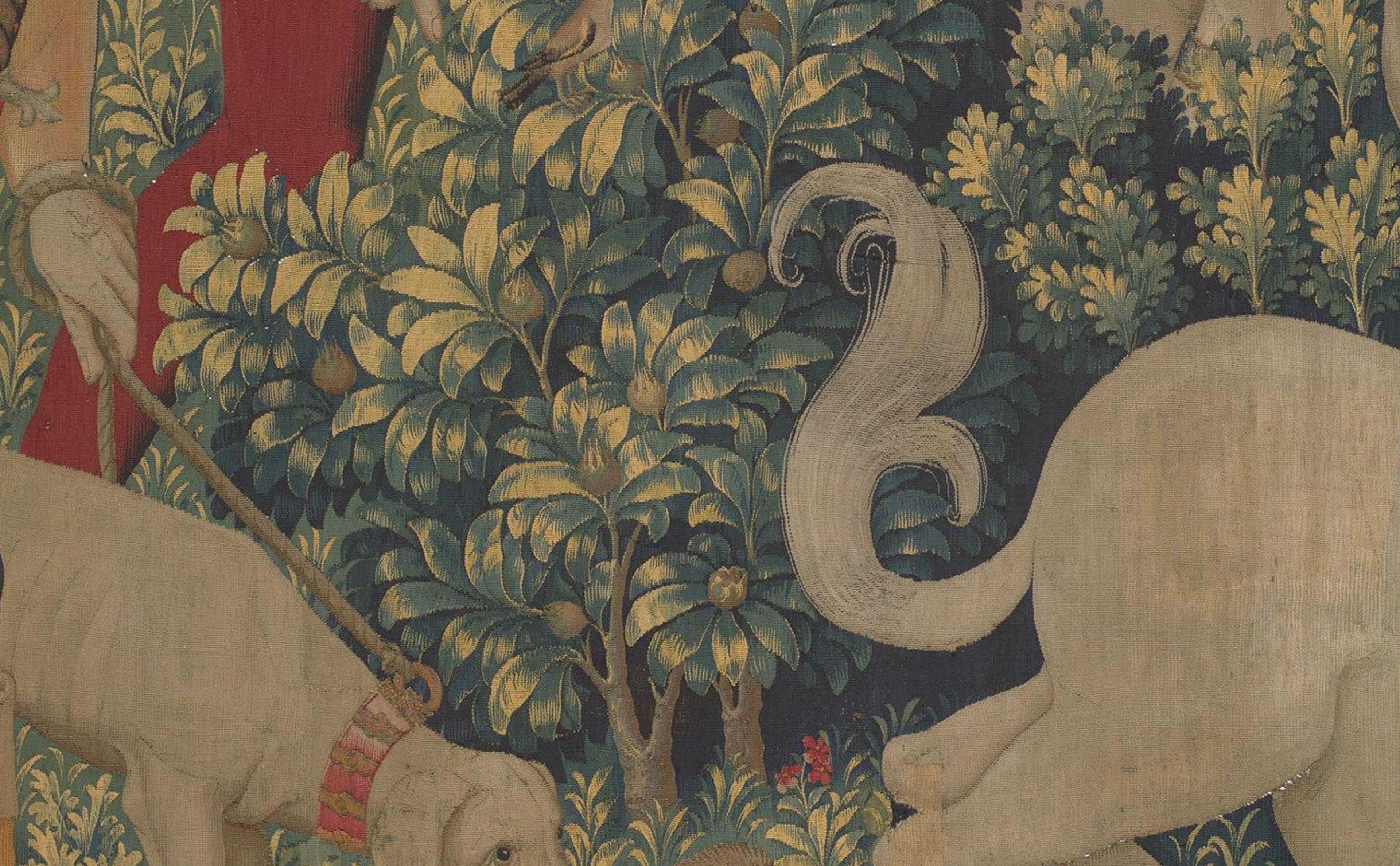The Medieval Garden Enclosed—Rotten-ripe: The Medlar Goes Soft

Left: Medlar in fruit below the west wall of Bonnefont Cloister Garden; right: a medlar tree in a detail from the tapestry The Unicorn is Found.
Well into November, long after other autumnal fruits have fallen to the ground, the small greenish-brown fruits of the medlar tree (Mespilus germanica) cling to its crooked boughs. The fruit is not harvested until the leaves fall, when the medlars can be easily plucked, although they are still too hard and acerbic to be eaten out of hand. Experts differ as to whether exposure to a few degrees of frost, which does the fruit no harm, is important to the long ripening process to come. Once gathered, the fruits are placed stem-side down in straw and stored in a cool, dark place for several weeks until they are rotten-ripe and the pulp has turned into a delicious mush a process known as bletting (Lee Reich, Uncommon Fruits Worthy of Attention, 1992).
Even less familiar to Americans than the quince, the medlar was a familiar orchard fruit in the Middle Ages. Its peculiar shape differentiates the medlar from its relatives. Unlike in apples and pears, the flesh of the medlar does not grow all the way around the core, but forms a wide depression at the blossom end of the fruit.

Medlars begin to bear at an early age, and the three small medlar trees planted below the east wall of Bonnefont Cloister Garden three years ago now boast a few dozen fruits. The kind grown here is 'Nottingham,' reputed to be the tastiest of several available cultivars. We plan to blet our little crop in straw and enjoy them in the simplest way, just by sucking the softened pulp from the skins, savoring the distinctive taste, which is something like a spicy apple butter, and spitting out the five large pips. Medlars also make excellent jellies and tarts.
A medlar tree appears twice in the wooded landscape of the Unicorn Tapestries: once in The Unicorn is Found and again in The Unicorn Defends Itself.

A familiar orchard fruit throughout Europe in the Middle Ages, the medlar is even less well-known in this country than its relative the quince. Like apples and pears, quinces and medlars are members of the Maloideae, a subfamily of the Rosaceae, or rose, family.
Despite the species name germanicus, the medlar is native to Asia Minor and to southeastern Europe; it is thought to have been brought to Germany by the Romans, and is now widely naturalized throughout central and northern Europe. It is one of several kinds of fruit trees shown growing in the monastic orchard-cemetery on the plan of St. Gall, and is listed in a ninth-century edict, the Capitulare de villis, in which the emperor Charlemagne decreed which plants were to be grown on the imperial estates.
The tenth-century Saxon grammarian Aelfric translated the Latin mespilus as "openaers," and that rude Old English name was still in use in Chaucer's day:
But if I fare as dooth an open-ers
That ilke fruit is ever lenger the wers
Til it be roten in mullock or in straw
We olde men, I drede, so fare we:
Til we be roten, kan we nat be rype;
Translation:
Unless I fare as does the fruit of the medlar
That same fruit continually grows worse
Until it is rotten in rubbish or in straw.
We old men, I fear, fare like that:
Until we are rotten, we can not be ripe.
From The Reeve's Prologue, ll. 3872-3875. (Interlinear translation by L. D. Benson.)
As with many medieval food plants, the medlar had medicinal virtues. The anatomically suggestive form was a sign of its therapeutic benefit:
Eat Medlars, if you have a looseness gotten,
They bind, and yet your urine they augment,
They have one name more fit to be forgotten,
While hard and sound they be, they be not spent,
Good Medlars are not ripe, til seeming rotten,
For meddling much with Medlars some are shent.
From Chapter 102 of The Englishman's Doctor, Sir John Harington's 1607 translation of the medieval Regimen Sanitatis.
Photographs by Barbara Bell
Deirdre Larkin
Deirdre Larkin is the managing horticulturist at The Met Cloisters museum and gardens.